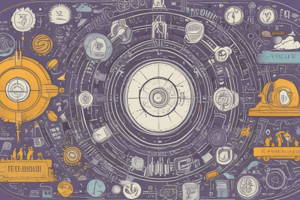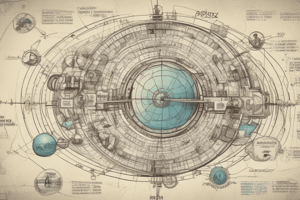Podcast
Questions and Answers
What characterizes software products in comparison to custom software?
What characterizes software products in comparison to custom software?
- They provide functionality useful to a broad range of customers. (correct)
- They are less costly to develop.
- They are tailored specifically for a single customer.
- They require more extensive documentation.
What is the typical lifetime of custom software systems?
What is the typical lifetime of custom software systems?
- Around 3 years
- Less than 5 years
- Indefinite with no support needed
- 10 years or more (correct)
In project-based software engineering, who owns the software requirements?
In project-based software engineering, who owns the software requirements?
- An external client (correct)
- The business processes
- The software company
- The software engineer
How do customers typically interact with the requirements of custom software?
How do customers typically interact with the requirements of custom software?
What are software products generally developed to support?
What are software products generally developed to support?
What type of software engineering methods have evolved specifically for product-based software?
What type of software engineering methods have evolved specifically for product-based software?
Which type of software product is categorized under large-scale business systems?
Which type of software product is categorized under large-scale business systems?
What is a key aspect of custom software development in relation to its longevity?
What is a key aspect of custom software development in relation to its longevity?
What is a key responsibility of product managers during the software's lifecycle?
What is a key responsibility of product managers during the software's lifecycle?
Which aspect is NOT typically a concern for product managers?
Which aspect is NOT typically a concern for product managers?
What must product managers do to stay aligned with customer expectations?
What must product managers do to stay aligned with customer expectations?
What is the product manager's role in product vision management?
What is the product manager's role in product vision management?
How do product managers address technology issues?
How do product managers address technology issues?
Which of the following best describes the primary focus of product managers?
Which of the following best describes the primary focus of product managers?
What aspect of a product's lifecycle do product managers NOT oversee?
What aspect of a product's lifecycle do product managers NOT oversee?
What type of products do researchers typically develop?
What type of products do researchers typically develop?
What should be your primary aim when building a prototype for a software product?
What should be your primary aim when building a prototype for a software product?
What is the end goal of the two-stage prototyping process?
What is the end goal of the two-stage prototyping process?
What should occur after developing a prototype?
What should occur after developing a prototype?
Which responsibility is NOT typically associated with product managers?
Which responsibility is NOT typically associated with product managers?
What type of software products are generally developed to serve a wide range of customers?
What type of software products are generally developed to serve a wide range of customers?
In the context of software development, what does 'feasibility demonstration' primarily focus on?
In the context of software development, what does 'feasibility demonstration' primarily focus on?
When developing an existing prototype into one for customer demonstration, what is necessary before proceeding?
When developing an existing prototype into one for customer demonstration, what is necessary before proceeding?
What characterizes service-based systems in software products?
What characterizes service-based systems in software products?
What is the primary purpose of a product roadmap?
What is the primary purpose of a product roadmap?
Who should lead the development of user stories and scenarios?
Who should lead the development of user stories and scenarios?
What is the role of the product manager in the acceptance testing process?
What is the role of the product manager in the acceptance testing process?
What is the main focus during customer testing?
What is the main focus during customer testing?
What does product prototyping aim to demonstrate?
What does product prototyping aim to demonstrate?
What is a product backlog primarily used for?
What is a product backlog primarily used for?
Which of the following is NOT a responsibility of the product manager?
Which of the following is NOT a responsibility of the product manager?
What is meant by 'vision drift' in product management?
What is meant by 'vision drift' in product management?
What initiates the process of product development in software engineering?
What initiates the process of product development in software engineering?
What is the primary responsibility of the software development company during product development?
What is the primary responsibility of the software development company during product development?
What characterizes a software product line?
What characterizes a software product line?
Which statement best describes a platform in software engineering?
Which statement best describes a platform in software engineering?
What is a notable feature of comparable software development mentioned in the content?
What is a notable feature of comparable software development mentioned in the content?
How does rapid delivery of software products impact the market?
How does rapid delivery of software products impact the market?
In the context of software product development, what is NOT considered a responsibility of the development company?
In the context of software product development, what is NOT considered a responsibility of the development company?
Which of the following is an example of a platform that allows for extra functionality?
Which of the following is an example of a platform that allows for extra functionality?
Flashcards
Product Software Engineering
Product Software Engineering
A software product developed and sold to capture a market opportunity.
Software Product Line
Software Product Line
A set of software products sharing a common core with customer-specific additions.
Software Platform
Software Platform
A software or software/hardware combination providing functionality for app development.
Rapid Delivery
Rapid Delivery
Signup and view all the flashcards
Comparable Software Development
Comparable Software Development
Signup and view all the flashcards
Student Projects
Student Projects
Signup and view all the flashcards
Assignment-Based Software
Assignment-Based Software
Signup and view all the flashcards
Independent Development
Independent Development
Signup and view all the flashcards
Product Roadmap
Product Roadmap
Signup and view all the flashcards
Product Backlog
Product Backlog
Signup and view all the flashcards
Product Prototyping
Product Prototyping
Signup and view all the flashcards
Acceptance Testing
Acceptance Testing
Signup and view all the flashcards
Customer Testing
Customer Testing
Signup and view all the flashcards
User Stories and Scenarios
User Stories and Scenarios
Signup and view all the flashcards
Technical Interactions of Product Managers
Technical Interactions of Product Managers
Signup and view all the flashcards
Avoid Vision Drift
Avoid Vision Drift
Signup and view all the flashcards
Research software development
Research software development
Signup and view all the flashcards
Internal Tool Development
Internal Tool Development
Signup and view all the flashcards
Software product management
Software product management
Signup and view all the flashcards
Product Manager (PM)
Product Manager (PM)
Signup and view all the flashcards
Business needs
Business needs
Signup and view all the flashcards
Technology constraints
Technology constraints
Signup and view all the flashcards
Customer experience
Customer experience
Signup and view all the flashcards
Product Vision
Product Vision
Signup and view all the flashcards
Custom Software
Custom Software
Signup and view all the flashcards
Software Product
Software Product
Signup and view all the flashcards
Project-based Software
Project-based Software
Signup and view all the flashcards
Software Requirements
Software Requirements
Signup and view all the flashcards
Software Maintenance
Software Maintenance
Signup and view all the flashcards
Software Contractor
Software Contractor
Signup and view all the flashcards
Software Lifetime
Software Lifetime
Signup and view all the flashcards
Requirement Change
Requirement Change
Signup and view all the flashcards
Software Prototype
Software Prototype
Signup and view all the flashcards
Feasibility Demonstration Prototype
Feasibility Demonstration Prototype
Signup and view all the flashcards
Customer Demonstration Prototype
Customer Demonstration Prototype
Signup and view all the flashcards
Product Manager
Product Manager
Signup and view all the flashcards
Study Notes
Software Products
- Software products are generic systems offering functionalities useful to various customers.
- Examples range from large-scale business systems (e.g., MS Excel) to personal software (e.g., Evernote), simple mobile apps, and games (e.g., Sudoku).
- Software product engineering evolved from methods supporting one-off custom software.
- Custom software remains essential for large businesses and public bodies, developed through dedicated projects.
Project-Based Software Engineering
- Starts with a set of software requirements outlined by an external client, defining the system's tasks.
- A software company (contractor) develops the system per these requirements.
- Clientele frequently change requirements in response to business changes.
- Contractors must adapt the software to reflect these adjustments.
- Custom software projects typically have extended lifecycles (10+ years) requiring ongoing support.
Product Software Engineering
- Starts with a recognized business opportunity.
- A company creates a software product to leverage this opportunity for customer sale.
- The software company designs and develops features.
- The software development company decides the project timeline, what features to include, and when changes are needed.
- Rapid product delivery is critical for market capture.
Software Product Lines and Platforms
- A product line comprises software products sharing core functionality.
- Each product in a line has customer-specific additions and adaptations.
- Software product lines facilitate fulfilling custom needs not met by a generic product.
- A platform is a software (sometimes combined with hardware) product enabling new applications' creation.
- Real-world examples include Facebook, offering extensive functionality and support for creating apps.
Software Execution Models
- Stand-alone execution: software runs on the user's computer, with all functionality and data residing there.
- Hybrid execution: a blend of stand-alone and service-based execution, with some functions and parts of the data stored on the user's computer and others on the vendor's server.
- Software as a service: software functionality runs on the vendor's servers, with users accessing it through a user interface. Data is managed on vendor servers; updates and changes are managed by the vendor,
Comparable Software Development
- Product development lacks an external customer providing requirements.
- This characteristic also applies to student projects (for a course), research software (analyzing research questions), and internal tools (for company use).
Software Product Management
- It is a business activity focused on software products developed and sold by a business.
- Product managers (PMs) control overall responsibility.
- This role incorporates planning, development, and product marketing.
- PMs serve as the interface between the business, customers, and the development team.
- PMs manage the product lifecycle from inception to withdrawal from the market, ensuring alignment with business goals and customer needs.
Product Management Concerns
- PMs ensure products align with business goals.
- Effective communication of technology concerns to the development team.
- Sustaining regular communication with customers and prospective customers to understand their needs and requirements.
Technical Interactions of Product Managers
- Product vision management: establishing and maintaining consistency in the product's vision.
- Product roadmap development: defines the development, release, and marketing strategies.
- User story and scenario development: PMs define how customers interact with the product.
- Product backlog creation and management: prioritize tasks for software development.
- Acceptance testing: verifies software aligns with goals and functionality.
- Customer testing: gathers feedback on product operation and usability.
Product Prototyping
- Product prototyping: creating an initial version to test ideas and secure funding.
- Essential for visually demonstrating product functionalities for potential customers.
- Two-stage prototyping (feasibility, customer demonstration) allows a structured approach.
Key Points 1 and 2
- Software products comprise widely applicable functionalities.
- In product engineering: the same organization handles product feature definition and development.
- Software products may exist as stand-alone, hybrid, or service-based systems.
- Key product management responsibilities include product vision, roadmap, user stories, backlog, and testing; PMs facilitate communication amongst stakeholders.
Studying That Suits You
Use AI to generate personalized quizzes and flashcards to suit your learning preferences.




